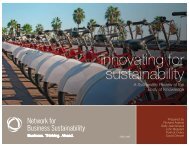embedding sustainability in organizational culture - Network for ...
embedding sustainability in organizational culture - Network for ...
embedding sustainability in organizational culture - Network for ...
Create successful ePaper yourself
Turn your PDF publications into a flip-book with our unique Google optimized e-Paper software.
Chapter 1: 3: Introduction Foster<strong>in</strong>g Commitment<br />
25<br />
While none of the research reviewed here explicitly explored storytell<strong>in</strong>g’s impact on<br />
<strong>embedd<strong>in</strong>g</strong> <strong>susta<strong>in</strong>ability</strong>, several practitioners and researchers suggested its value.<br />
More research is needed to understand the potential value of storytell<strong>in</strong>g.<br />
assessment: proposed but not tested<br />
cuStoMizE: Make or alter to <strong>in</strong>dividual or group specifications<br />
• Translate and adjust your message <strong>for</strong> different groups or, <strong>in</strong> the<br />
case of mult<strong>in</strong>ational firms, <strong>for</strong> different <strong>culture</strong>s<br />
• Adjust your message <strong>for</strong> delivery <strong>in</strong> different types of media<br />
• Trans<strong>for</strong>m your message by adjust<strong>in</strong>g the term<strong>in</strong>ology <strong>for</strong> different<br />
operational divisions and levels<br />
Customization is about tak<strong>in</strong>g the key messages about <strong>susta<strong>in</strong>ability</strong> and mak<strong>in</strong>g<br />
them more relevant <strong>for</strong> the <strong>in</strong>tended audience. Different groups with<strong>in</strong> the<br />
organization may be receptive to different styles and means of communication.<br />
In the case of mult<strong>in</strong>ational firms, this may <strong>in</strong>volve address<strong>in</strong>g the local context<br />
to ensure the message has local relevance (Ethical Corporation, 2009). Esquer-<br />
Peralta et al. (2008) suggest the need to tailor your message by us<strong>in</strong>g term<strong>in</strong>ology<br />
that will be familiar to the particular audience. Part of the process of <strong>embedd<strong>in</strong>g</strong><br />
<strong>susta<strong>in</strong>ability</strong> appears to <strong>in</strong>volve translat<strong>in</strong>g abstract <strong>susta<strong>in</strong>ability</strong> concepts <strong>in</strong>to<br />
language that enables employees to understand their application <strong>in</strong> day-to-day<br />
bus<strong>in</strong>ess (Wei-Skillern, 2004). Reverdy (2006) notes that cross-functional work<br />
groups can be helpful <strong>in</strong> this translation process.<br />
The safety literature identifies the need to customize outside, related practices <strong>for</strong><br />
the local context when creat<strong>in</strong>g a <strong>culture</strong> of safety (McCarthy & Blumenthal, 2006);<br />
and the need modify standard targets to particular sett<strong>in</strong>gs <strong>in</strong> order to ga<strong>in</strong> team<br />
member buy-<strong>in</strong> (Manley, 2000).<br />
There is prelim<strong>in</strong>ary support <strong>for</strong> the value of customiz<strong>in</strong>g key <strong>susta<strong>in</strong>ability</strong><br />
messages. More research is needed to understand this practice.<br />
assessment: Weakly supported<br />
manage talent<br />
The practices <strong>in</strong> this category describe how staff<strong>in</strong>g decisions support the transition<br />
toward <strong>susta<strong>in</strong>ability</strong>. Manag<strong>in</strong>g talent <strong>in</strong>volves hir<strong>in</strong>g people with the passion,<br />
attitude and competence to deal with environmental and <strong>susta<strong>in</strong>ability</strong> issues<br />
<strong>in</strong> their daily work and plac<strong>in</strong>g the right people <strong>in</strong> the right roles across the<br />
organization. We cover three practices <strong>in</strong> this section: recruit<strong>in</strong>g, allocat<strong>in</strong>g and<br />
promot<strong>in</strong>g.<br />
REcRuit: identify and hire people with a <strong>susta<strong>in</strong>ability</strong> orientation or<br />
<strong>susta<strong>in</strong>ability</strong> skills<br />
• Refer to <strong>susta<strong>in</strong>ability</strong> values, goals and per<strong>for</strong>mance <strong>in</strong> recruit<strong>in</strong>g<br />
materials<br />
• Integrate <strong>susta<strong>in</strong>ability</strong> <strong>in</strong>to all job advertisements<br />
• Make <strong>susta<strong>in</strong>ability</strong> part of all job descriptions <strong>for</strong> new hires<br />
• Select new employees on the basis of a commitment to <strong>susta<strong>in</strong>ability</strong><br />
• Attempt to foster productive diversity through hir<strong>in</strong>g decisions<br />
To build and support a <strong>culture</strong> of <strong>susta<strong>in</strong>ability</strong>, an organization’s recruit<strong>in</strong>g and<br />
selection processes should strategically build a pool of human capital with values<br />
and skills that support the journey toward <strong>susta<strong>in</strong>ability</strong>. Companies with a strong<br />
reputation <strong>for</strong> <strong>susta<strong>in</strong>ability</strong> will attract candidates seek<strong>in</strong>g to work <strong>in</strong> a susta<strong>in</strong>able<br />
company. An organization transition<strong>in</strong>g toward <strong>susta<strong>in</strong>ability</strong> should consider<br />
referr<strong>in</strong>g to its <strong>susta<strong>in</strong>ability</strong> values, goals and per<strong>for</strong>mance <strong>in</strong> recruit<strong>in</strong>g materials<br />
to attract candidates that will align with these values (Epste<strong>in</strong>, 2008; Ethical<br />
Corporation, 2009; Goodman, 2000).<br />
Doppelt (2003) suggests <strong>in</strong>clud<strong>in</strong>g <strong>susta<strong>in</strong>ability</strong> <strong>in</strong> the job descriptions <strong>for</strong> new<br />
hires. Dunphy and colleagues (2003) raised the importance of foster<strong>in</strong>g productive<br />
diversity through hir<strong>in</strong>g decisions. Standberg (2009) notes that it is important not<br />
to overlook probationary reviews after a hir<strong>in</strong>g decision has been made—this is the<br />
ideal time to confirm the employee’s commitment to <strong>susta<strong>in</strong>ability</strong>.<br />
Despite several references to the importance of hir<strong>in</strong>g among both researchers and<br />
practitioners, there is little research that exam<strong>in</strong>es the impact of hir<strong>in</strong>g on creat<strong>in</strong>g a<br />
<strong>culture</strong> that supports <strong>susta<strong>in</strong>ability</strong>.<br />
assessment: proposed but not tested<br />
allocatE pEoplE: Move the staff who are passionate about, or skilled <strong>in</strong>,<br />
<strong>susta<strong>in</strong>ability</strong> <strong>in</strong>to key roles<br />
• Identify people with a passion <strong>for</strong> <strong>susta<strong>in</strong>ability</strong> and place them <strong>in</strong><br />
key roles
















